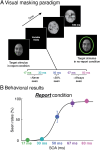Neural signatures of visual awareness independent of postperceptual processing
- PMID: 39535504
- PMCID: PMC11558846
- DOI: 10.1093/cercor/bhae415
Neural signatures of visual awareness independent of postperceptual processing
Abstract
What are the neural processes associated with perceptual awareness that are distinct from preconscious sensory encoding and postperceptual processes such as reporting an experience? Using electroencephalography and a no-report visual masking paradigm, we manipulated stimulus visibility by varying the time between stimuli and masks in linear steps (17, 33, 50, 67, and 83 ms). Awareness increased nonlinearly, with stimuli never seen at the two shortest intervals, always seen at the two longest, and 50% seen at the intermediate interval. Separate report and no-report conditions were used to isolate awareness from task performance. Our results revealed a neural signal closely linked to perceptual awareness, independent of the task: a fronto-central event-related potential that we refer to as the N2 (~250 to 300 ms). Earlier event-related potential signals reflected the linear manipulation of stimulus strength, while later signals like P3b and temporal generalization of decoding were tied to task performance, appearing only in the report condition. Taken together, these findings inform current debates regarding theories of consciousness and offer new avenues for exploring the neural mechanisms supporting conscious processing.
Keywords: EEG; attention; awareness; consciousness; perception; vision.
© The Author(s) 2024. Published by Oxford University Press.
Figures








Similar articles
-
Early and Late ERP Correlates of Conscivousness- A Direct Comparison Between Visual and Auditory Modalities.Psychophysiology. 2025 Jul;62(7):e70099. doi: 10.1111/psyp.70099. Psychophysiology. 2025. PMID: 40600519 Free PMC article.
-
Distinguishing the Neural Correlates of Perceptual Awareness and Postperceptual Processing.J Neurosci. 2020 Jun 17;40(25):4925-4935. doi: 10.1523/JNEUROSCI.0120-20.2020. Epub 2020 May 14. J Neurosci. 2020. PMID: 32409620 Free PMC article.
-
Short-Term Memory Impairment.2024 Jun 8. In: StatPearls [Internet]. Treasure Island (FL): StatPearls Publishing; 2025 Jan–. 2024 Jun 8. In: StatPearls [Internet]. Treasure Island (FL): StatPearls Publishing; 2025 Jan–. PMID: 31424720 Free Books & Documents.
-
Laser therapy for retinopathy in sickle cell disease.Cochrane Database Syst Rev. 2022 Dec 12;12(12):CD010790. doi: 10.1002/14651858.CD010790.pub3. Cochrane Database Syst Rev. 2022. PMID: 36508693 Free PMC article.
-
Interventions for central serous chorioretinopathy: a network meta-analysis.Cochrane Database Syst Rev. 2025 Jun 16;6(6):CD011841. doi: 10.1002/14651858.CD011841.pub3. Cochrane Database Syst Rev. 2025. PMID: 40522203
References
Publication types
MeSH terms
Grants and funding
LinkOut - more resources
Full Text Sources

